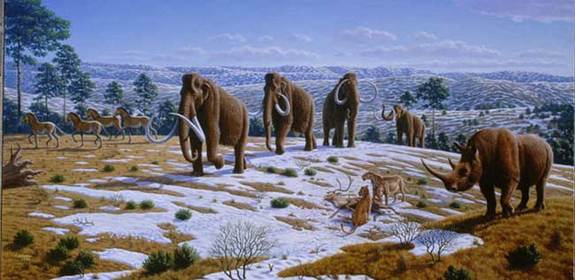Mammoth or Mastodon: What's the Difference?

Mammoths and mastodons may have once roamed the Earth together, but they represent two distinct species of the Proboscidean family. And while these extinct giants have a lot in common, they also exhibit some interesting differences.
Mammoths, belonging to the genus Mammuthus, arose about 5.1 million years ago in Africa, according to Ross MacPhee, Ph.D., curator at the American Museum of Natural History in New York. From Africa, the mammoths migrated throughout Eurasia and North America. Their evolution continued over millions of years, eventually producing the woolly mammoth, M. primigenius, beginning roughly 250,000 years ago.
Mammoths went extinct about 10,000 years ago, though scientists believe an isolated population of dwarf mammoths persisted on Wrangel Island off the northeastern coast of Siberia until about 3,700 years ago. Mammoths and modern elephants are closely related members of the same family (Elephantidae).
And though they might resemble their distant, mammoth cousins, mastodons came into existence even earlier, about 27 million to 30 million years ago. They lived primarily in North and Central America and, like mammoths, began to disappear between 12,000 and 10,000 years ago.
Some scientists believe early humans may have hunted both species to extinction, though there is considerable evidence that several factors, including climate change and variations in habitat, contributed to the disappearance of mammoths and mastodons.
While similar in size and stature, fossil evidence shows that mastodons were slightly smaller than mammoths, with shorter legs and lower, flatter heads. Both species stood between 7 and 14 feet (2 meters to 4 meters) tall, and were covered in long, shaggy hair that protected them from the harsh conditions of their respective environments.
But mammoths also possessed fatty humps on their backs that provided them with the additional nutrients necessary in their more northerly, ice-covered habitats.
Get the world’s most fascinating discoveries delivered straight to your inbox.
The most important difference between these two species, according to Smithsonian.com, lies in how they ate their food. Both animals were herbivores, but mastodons had cone-shaped cusps on their molars designed to crush leaves, twigs and branches.
Mammoths, however, had ridged molars that allowed them to cut through vegetation and graze like modern-day elephants. Both species had long, curved trunks that the animals may have used to scrape snow and ice off vegetation.
Follow LiveScience on Twitter @livescience. We're also on Facebook & Google+.

